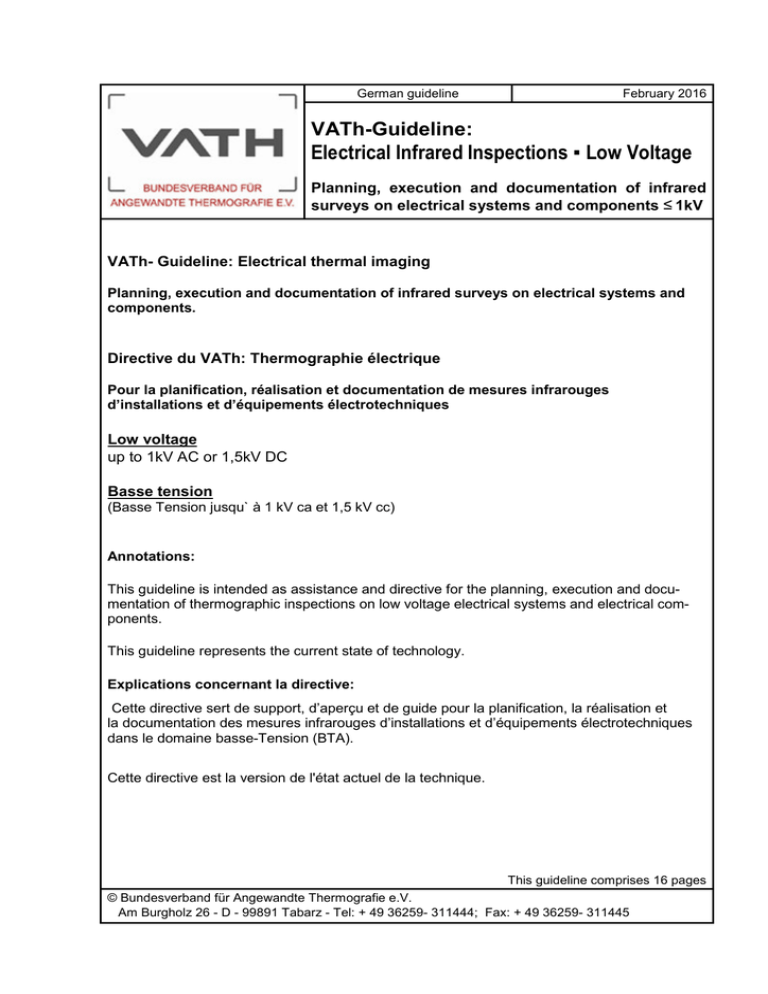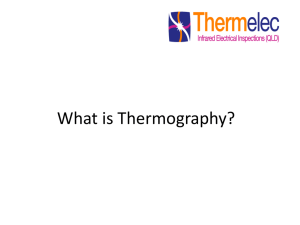
German guideline
February 2016
VATh-Guideline:
Electrical Infrared Inspections ▪ Low Voltage
Planning, execution and documentation of infrared
surveys on electrical systems and components ≤ 1kV
VATh- Guideline: Electrical thermal imaging
Planning, execution and documentation of infrared surveys on electrical systems and
components.
Directive du VATh: Thermographie électrique
Pour la planification, réalisation et documentation de mesures infrarouges
d’installations et d’équipements électrotechniques
Low voltage
up to 1kV AC or 1,5kV DC
Basse tension
(Basse Tension jusqu` à 1 kV ca et 1,5 kV cc)
Annotations:
This guideline is intended as assistance and directive for the planning, execution and documentation of thermographic inspections on low voltage electrical systems and electrical components.
This guideline represents the current state of technology.
Explications concernant la directive:
Cette directive sert de support, d’aperçu et de guide pour la planification, la réalisation et
la documentation des mesures infrarouges d’installations et d’équipements électrotechniques
dans le domaine basse-Tension (BTA).
Cette directive est la version de l'état actuel de la technique.
This guideline comprises 16 pages
© Bundesverband für Angewandte Thermografie e.V.
Am Burgholz 26 - D - 99891 Tabarz - Tel: + 49 36259- 311444; Fax: + 49 36259- 311445
VATh-Guideline Electro-Thermography, Part B: Low voltage
Page 2
VATh- Guideline: „Electro-Thermography“
Version from: February 2016
Editor:
Bundesverband für Angewandte Thermografie e.V.
Am Burgholz 26
D-99891 Tabarz
Tel: + 49 36259 -311444
Fax: + 49 36259 -311445
© All rights reserved by Bundesverband für Angewandte Thermografie e.V.
All statements are based on the current standard of knowledge. The Bundesverband cannot
accept any responsibility or liability. Recommendations or objections for upcoming versions
should be addressed to the office of the Bundesverband.
In the case of disputes the German version of this guideline is relevant.
Table of contents
1.
Educational prerequisites and skills
3
2.
Health
3
3.
Safety distance
4
4.
Safety equipment
4
5.
Regulations
4
6.
Procedure
4
7.
Measuring equipment
5
8.
Evaluation software
6
9.
Assessment and reporting
6
10.
Basic document
6
11.
Evaluation document
7
12.
Classification of thermal anomalys
8
13.
Thermography on photovoltaic-generators
9
14.
Attachment A, Chart 1, Electro Thermography
13
15.
Attachment B, Error catalog Photovoltaic-Thermography
15
VATh-Guideline Electro-Thermography, Part B: Low voltage
Page 3
1. Educational prerequisites and personal skills
The following prerequisites must be fulfilled and represents the basis for a qualified thermographic training:
a) A completed apprenticeship in the field of electrical engineering with the skill of a journeyman, master craftsman or engineer. Engineers, who graduated from a college or
technical college without having completed an apprenticeship as an electrically qualified
person, must provide a certificate according to DIN VDE 1000-10 / 4.2.
b) At least two years of professional experience in the field of Electro-Thermography and
several years of experience in the field of electronic engineering according to VDE100010 / 4.2 is required (Annotation: several years experience in the related field of activity).
It is mandatory to prove at least a successfully completed level 1 course according to DIN EN
ISO 9712* and a specific training course reagrding fundamentals of electrical components
along with the assessment of typical electrical thermal anomalies (e.g. DIN EN ISO 9712*,
Sector: Electrical Applications – Level 2).
According to the guidelines for personnel in the field of non-destructive testing, only the persons are allowed to run an inspection and evaluation without supervision of a level 2 or 3 certified person, if they are certified according to DIN EN ISO 9712*, Sector: Electrical Applications – Level 2 or 3.
Due to the generally increased fire risk, the person performing the inspection must be able to
assess temperature rises accurately. Therefore, only persons should conducting the survey,
who own a certificate “Electrical Thermographer, level 2” according to DIN EN ISO 9712* or
“VdS acknowledged specialist for Electro-Thermography” (VdS = German association of
property insurance companies) in order to meet the requirements of the insurance industry.
*: has displaced DIN EN 473 and DIN 54162 !
2. Health
The presentation of a certificate proofing the visual capacity according to DIN EN ISO 9712*
is indispensable and must be renewed annually.
Also it should be acknowledged that the work in the field of Electro-Thermography is associated with increased health risks. Especially, people with pacemakers or a disposition for dizziness and epileptic seizures need to be aware of that.
VATh-Guideline Electro-Thermography, Part B: Low voltage
Page 4
3. Safety distance
By definition conducting an electrical inspection is considered to be included in the category
“working in hazardous electrical energized areas”. As a consequence of working close to
electrically energized components the following safety distance must be mantained according to VDE 0105, Table 102:
Nominal voltage in volts [V]
50 < U~ < 1000
U= < 1000
Safety distance in meters [m]
0,5
4. Safety equipment
According to valid accident prevention regulations and other valid regulations the thermographer has to wear personal safety equipment for his own protection.
5. Regulations
Thermographic personnel inspecting electrical systems should generally be independent (no
in-house personnel). This ensures that neither superior nor the company management has
influence on the inspection. Safety and fire prevention always comes first.
6. Procedure
The thermographic inspection should be scheduled to fulfill the following conditions:
a) a minimum of 20% load of the inspected electrical components regarding to their maximum nominal load.
b) the condition mentioned in item a) must be maintained long enough to ensure that the
components have reached a thermal equilibrium state while running the inspection.
Since the two conditions listed above are not always fully realizable and since the thermography of electrical systems is to be considered a snap-shot, it is advisable to run an inspection at regular intervals. This will improve the statistical certainty to detect anomalies. A separate risk assessment has to be performed by the employer.
It is recommended, that the end user shall provide a qualified assistant to accompany the infrared thermographer during the inspection. The qualified assistant should be knowledgeable
of the operation and history of the equipment to be examined
VATh-Guideline Electro-Thermography, Part B: Low voltage
Page 5
7. Infrared Camera Equipment
The infrared imaging system beeing used has to meet the following requirements:
Spectral Range:
Cameras working in the MW (Mid-Wave: 35 µm) or LW (Long-Wave: 8-12 µm) spectral band can be used.
Measurement Temperature Range
-20° to +500°C
(or higher)
OperatingTemperature Range
-10° to +40°C
(or higher)
Basic Type:
A split camera/controller concept (monitor
and remote control unit separated or alternatively a turnable monitor) is necessary in
order to run the inspection also in areas
with difficult access
Lenses:
Usually a lens out of the available standard
lens set must be used
- Wide angle lens
- Standard angle lens
- Tele lens
depending on the particular scope
Thermal resolution:
≤ 100 mK
Geometrical resolution:
≤ 1,5 mrad ( = IFOV of Standard lens)
Detector Pixel resolution:
min. 320 x 240 Pixel
Temporal resolution:
min. 20 frames/sec
Measurement accuracy:
±2K or ±2%
Basic operating functionality:
The camera must offer the capabilities to:
- focus the image precisely
- freeze an image
- switch between color and gray palettes
- activate measurement functions:
moveable spot and area
- adjust all measurement parameters
- manual scaling and display the thermogram
- saving radiometric data
Power supply:
-
A self-contained operation on battery
power is indispensable.
Calibration:
-
Periodical factory-calibrations (according to the manufacturers requirements)
Frequent automatic comparison/compensation to an internal temperature reference inside the camera
-
recommended: ≤ 60 mK
VATh-Guideline Electro-Thermography, Part B: Low voltage
Page 6
A validation of the temperature calibration
must be done and documented annually.
It is recommended to perform a simple
calibration check even more frequently.
8. Analysis and reporting software
The expert must own or have access to a suitable software which allows processing, analyzing and reporting the infrared images afterwards. It must be possible to change the measurement parameters used to convert the measured radiation density into temperature and
also labeling the results after the inspection.
9. Assessment and Reporting
The inspection report consists of a basic document and the actual evaluation document
page(s). The particular style of these documents are due to the thermographer. Nevertheless, the data and annotations listed below must be included.
In addition the VdS guideline 2860 applies to persons qualified as “VdS acknowledged specialist for Electro-Thermography”.
10. Basic document
The following data has to be included on the basic document:
1. Employer
2. Contractor
3. Inspected objects
4. Scope of the inspection
5. Name of the operating thermographer and accompanying persons
6. Date of inspection
7. The used infrared camera system incl. the applied lenses
8. Auxiliary measuring instruments that were used like clamp meter, thermometer, hygrometer, anemometer, pyrometer etc.
9. In case of outdoor inspections the weather conditions (including air temperature [°C],
relative humidity [%], wind speed [m/s], Global radiation [W/m2])
VATh-Guideline Electro-Thermography, Part B: Low voltage
Page 7
11. Evaluation document
Usually, the evaluation document includes a report, a listing of all inspected system components and the thermograms. Every thermogram should be presented on a separate page
measuring at least 80 x 60mm (temperature scale not included). The following information
regarding the thermograms must to be presented on this page:
1. A photo with the same image content taken from the same position.
2. The date and exact time the image was taken plus the name of the recorded image file.
3. An accurate object description (building, switchyard, switchboard, control panel, component nr/code etc.)
4. Preferably the load of the component when the image was saved in ampere [A] and/or
as percentage [%] of the nominal load.
5. The temperature of the thermal anomaly with the exact location and/or the temperature
difference between the fault location and an identical faultless component. The given information must be clear enough that the client can retrace the shown temperature values, resp. temperature difference.
6. Voltage level
7. Fault classification
All inspected components, that have been classified as “thermal abnormality” or “dangerous
thermal abnormality” according to DIN 54191 during the evaluation period, must be listed in
the evaluation report as well as interpreted by the operating thermographer, if necessary
provided with annotations and recommendations.
A list including all inspected components along with the noticed anomalys and their classifications has to be added to the report. Non thermal anomalys can be documented by photos
as the circumstances require (e.g. heavy dust deposit on electrical systems).
12. Classification of thermal anomalies
According to DIN 54191 anomalies are classified as follows:
- no anomalies (ok);
- thermal abnormality (tA);
- dangerous thermal abnormality (gtA);
- inspection not possible (kB);
- non-thermal anomalies (ntA).
In order to categorize into severity assessment classes, the detected temperature of the suspicoius component must be compared either with a given temperature limit ( maximum al-
VATh-Guideline Electro-Thermography, Part B: Low voltage
Page 8
lowable temperature criteria) or with the temperatures of a similar component under similar
operating and environmental conditions ( temperature difference or ∆T criteria) as showed
in attachment A, chart 1.
Additionally, the measured temperature distribution and temperature gradient have to be reviewed according to the terminology “thermal anomaly”. With respect to DIN 54191, a thermal anomaly describes a state which is not consistent with the normal operation or can’t be
explained by the internal construction of the component. For a final classification of the detected anomaly the following circumstances must be considered:
a) -is the current load known and given constantly ?
b) -deviating surrounding conditions ?
c) -high density packing in the cabinet ?
d) -consideration of the diversity factor
e) -is a redundancy of the inspected component given ?
Severity class
[1] OK
[2] tA*
Recommendation
no further action
required
check possible
cause;
repair at next
sheduled shutdown, at most
within 6 months
[3] tA*
[4] gtA
check possible short-term deaccause;
tivation;
repair at next
check possible
sheduled shut- cause and repair
down, at most
as soon as poswithin 2 months sible; alternatively
reduce load
*: Thermal indications e.g. on electronic printed circuit boards can cause time-consuming
troubleshooting and may lead to long and costly downtimes. Therefore the “tA”-rating was
splitted into 2 classes (deviating from DIN EN 54191) which differs only with respect to the
recommended time frame for inspection and maintenance.
VATh-Guideline Electro-Thermography, Part B: Low voltage
Page 9
13. Thermography on photovoltaic-generators
With the increasing use of photovoltaic systems in the commercial as well as the private sector there is rising demand for an appropriate inspection technology to guarantee a safe and
profitable operation of these systems. Infrared thermography is highly qualified to be such an
inspection method and ist not just limited to commissioning inspections (first inspection in accordance with DIN EN 62446).
Basically, a thermographic inspection on photovoltaic-generators (photovoltaic-module units)
must be assigned to the field of electro-technical thermography, which requires a basic
knowledge of the functional principles of photovoltaic-generators as well as a founded understanding of thermography as an optical inspection method in order to be done accurately.
In addition to the previous chapters 1. to 12. this section contains annotations highlighting the
specific requirements for the infared inspection of photovoltaic-generators.
13.1. Training
In order to run a commissioning inspection, i.e. the first inspection after installation, the executing thermographer must understand the fundamental functionality of photovoltaicgenerators. Furthermore he needs to have sufficient knowledge of non-contact temperature
measurement technology by using radiometric infrared cameras. These requirements must
be proved by having participated an at least two day training focused on photovoltaic installations and photovoltaic thermography. Nevertheless it is strongly recommended to hold a level
1 certificate according to DIN EN ISO 9712. Table 2 in attachment B of this document shows
a compilation of the most common thermal patterns on photovoltaic-generators, meant to
help categorize suspicious patterns or anomalies found.
If thermal signatures are detected that differs from the examples in the compilation, a
certified thermographer needs to be consulted, holding at least a level 2 certificate according to DIN EN ISO 9712 - Sector: Electrical Applications.
For periodic inspections, systematic error diagnosis or system optimization it is considered helpful to consult an expert in the field of photovoltaic installation engineering
as well.
13.2. Safety equipment
If working in components that are likely to crash, the appropriate fall protection (e.g. safety
harness) needs to be used.
VATh-Guideline Electro-Thermography, Part B: Low voltage
Page 10
13.3. Other regulations
When inspecting roof integrated systems or systems without a fire resistant separation between the generator and the flammable roof structure (also foil roofs), the focus should be
put on fire protection issues. Therefore, the thermography personnel should be independent
from the operator and the constructor.
13.4. Operation procedure
First of all it needs to be ensured, that the photovoltaic system is in operation. For this purpose the following approaches can be helpful:
a. control the Information-display(s) on the DC-converter(s)
b. measure the string currents with a current clamp
c. cause a partial shading of a module and check the reaction with the infrared camera.
The thermographic inspection has to be executed under stable radation and weather conditions, i.e. an irradiation of at least 600 W/m² (at the pv-generator), a cloud coverage not exceeding 2/8 Cumulus and a wind speed of max. 4 Beaufort. After short-term radation- and
load changes (> 10% per minute) a settling time of at least 10 minutes should be kept before
proceeding the inspection. The radation conditions must be measured and documented during the inspection (irradiation power, measured parallel to the pv-generator surface). This allows a recalculation to nominal load conditions afterwards.
13.5. Infrared Camera Equipment
The infrared camera system beeing used should meet the following requirements:
Spectral Range:
A camera working in the LW (Long-Wave:
8-12 µm) spectral band would be preferable due to less solar reflections.
Basic Type:
A split camera/controller concept (monitor
and remote control unit separated or alternatively a turnable monitor) is necessary to
be able to see the camera monitor and the
inspected component simultaneously (especially at close distances)
Particular situations could require using the
built-in viewfinder or shielding the camera
monitor from direct sunlight.
Measurement Temperature Range
-20° to +120°C
(or higher)
OperatingTemperature Range
-10° to +40°C
(or higher)
VATh-Guideline Electro-Thermography, Part B: Low voltage
Page 11
Lenses:
Due to the typically strongly varying distances the camera should be equipped
with interchangeable lenses, e.g. a standard or wide angle lens (for short distances
and overview shots) and a tele lens (for
single cells at longer distances).
Alternatively flying recording platforms (socalled drones) can be used, which allows
flexible camera positions
Geometrical resolution:
It is essential to make sure that there are at
least 5x5 Pixel (native Detector pixel, no interpolation) on a single cell for an accurate
temperature measurement
PHOTO
Although most of the infrared cameras nowadays are equipped with an additional visible
camera, the performance of these built-in digital cameras is not sufficient regarding FOV
(field of view) and resolution. Therefore, a separate camera has to be used, which allows to
adjust the identical FOV like the infared camera and offers a sufficient spatial resolution to
resolve even small conductor strips.
Furthermore, the identification of single suspicious photovoltaic modules must be possible
even in large photovoltaic installations. Therefore the resolution capability of the visible camera should be at least 30 times the resolution of the infrared camera covering the same FOV.
13.6. Evaluation software
In addition to the features mentioned in chapter 8. Analysis and reporting software the software should allow to create polygon areas and providing the minimum-, maximum- and average temperatures along with automatic position markers of the maximum and minimum
temperature.
13.7. Documentation
Any typ of thermal anomaly must be documented by at least one thermogram. The radiometric data of these thermograms must to be saved and should be available to the customer to
its full extent (if needed). The framework conditions such as irridation power, cloude coverage, wind speed etc. must be documented in order to guarantee the reproducibility of the collected results.
Photovoltaic Installations with more than 100 modules
In case of large pv-installations with more than 100 modules, resp. an extensive number of
anomalies it is usually sufficient to provide a list of the anomalies found, comprising the
VATh-Guideline Electro-Thermography, Part B: Low voltage
Page 12
names of the radiometric image files and a description of the anomaly. But nevertheless, the
complete data-set must be available for the customer in the case of further queries.
In case of high volume findings with often very similar thermal patterns it is not necessary to
supply a photo to every thermogram for reasons of clarity and to keep a clear overview.
The exact position of every anomaly within the complete installation must be stated clearly by
applying two of the following options:
-
a thermogram where the position is apparent from the context
-
stating the position by refering to a “position”-list, e.g. a list, incorporating the x,ycoordinates of all modules
-
mark the relevant item (pv-module or cell) in the wiring diagram of the pv-installation
-
specifify the derial number of the module
-
marking of the affected module with a waterproof pen on its frame or on the back of
the module in the field
Stating the position information twice facilitates finding the suspicious module and reduces
the risk of confusion during repair activities.
Annex A, Chart 1
Component or material:
Temperature limit [°C]:
Overtemperature limit ∆T [K]:
copper, bare
100
60a
copper-zinc-alloy, bare
105
65a
copper or copper-zinc-alloy, tinned
105
65a
Copper or cooper-zinc-alloy, silver-coated or nickel-plated
110
70a
manually operated / metal
55
15a
manually operated / non-metal
65
25a
touchable / metal
70
30a
touchable / non-metal
80
40a
metal housing, close to cable bushings
80
40a
non-metal housing, close to cable bushings
90
50a
housing surfaces with internal power resistors
240
200a
PVC insulated
70
40b
heat-resistant PVC insulated lines (labeled: V2)
90
60b
heat-resistant rubber-wiring cable (e.g.: H07G-U/R/K)
110
80b
ETFE wiring cable
135
105b
-junctions / clamps
-accessible parts
-cables and electrical lines
VATh-Guideline Electro-Thermography, Part B: Low voltage
Page 14
Annex A, Chart 1 (continued)
Component or material:
Temperature limit [°C]:
Overtemperature limit ∆T [K]:
Heat-resistant silicone-cablet (e.g.: N2GFA, H05S-U/K, H05SS-F)
180
150b
rubber twin-, hose-, flat cables (e.g.: H03VH-Y, H03VV-F)
60
30b
-Insulating materials (with letter codes)
Y (e.g.: cotton, paper, polyethylene)
90
A (e.g.: paper, silk, impregnated with fluid insulating material)
105
E (e.g.: phenol-, melamine-, epoxy resin, triacetate film)
120
B (e.g.: micanites, fiberglass, ceramic, porcelain)
130
F (e.g.: micaceous, fiberglass)
155
H (e.g.: aromatic polyamides, polyimide, silicone)
180
N (e.g.: glass*, polytetrafluoroethyle, epoxy EW90)
200
Oil transformer
winding, thermic category A, cooling method OF or ON
105
65a
winding for cooling method OD
110
70a
oil in the upper part of the transformer
100
60a
Dry type transformer
According to insulation class
a: ambient temperature: 40°C, average over 24h maximum at 35°C
b: ambient temperature: 30°C
* only a good insulator until 300°C; at around 600°C glass is becoming a conductor!
This chart does not raise a claim to be complete. Extensions and limitations regarding the permitted limit temperatures have to be possibly looked up in
the relevant norms.
VATh-Guideline Electro-Thermography, Part B: Low voltage
Page 15
Annex B, Chart 2 Typical thermal patterns incl. severity assessment criteria and repair recommendations
Thermogram
Description
defect class ∆T [K]:
Recommendation
In-depth visible check;
Suspicious conductor strip
tA
>3K
tA
> 20 K
evaluation by a level 2 certified thermographer based on
detailed high-resolution backside thermogram/photo
Overheated cell
(make shure,
that it is no
shading effect)
replace module
In-depth visible check;
Heated junction
box
tA
>3K
evaluation by a level 2 certified thermographer based on
detailed thermogram of the
open junction box from the
backside
VATh-Guideline Electro-Thermography, Part B: Low voltage
Page 16
Annex B, Chart 2 Typical thermal patterns incl. severity assessment criteria and repair recommendations (continued)
Thermogram
Description
defect class ∆T [K]:
Recommendation
replace module;
Module with bypassed substring
tA
2- 7 K
tA
2- 7 K
(idle mode)
Several substrings bypassed
in case of increased risk of fire
(flammable material close to
the modele) this module must
be taken out immediately
replace module
Check module connectors;
Several modules in idle
mode
tA
2- 7 K
Check connection of the complete string at the AC-converter
resp. the state of the ACconverter
VATh-Guideline Electro-Thermography, Part B: Low voltage
Page 17
Annex B, Chart 2 Typical thermal patterns incl. severity assessment criteria and repair recommendations (continued)
Thermogram
Description
defect class ∆T [K]:
Recommendation
Check module connectors;
Modules in
short-circuit
mode
tA
2- 7 K
Check connection of the complete
string at the AC-converter resp. the
state of the AC-converter
Consult a thermograph level 2 or a
photovoltaic expert
Polarity of connectors reversed
Check polarity of module connectors;
tA
3- 12 K
Not a defect:
Single cell is
partly shaded
Recommend
to remove the 20- 70 K
object causing the shadow
-all thermograms with the friendly assistance of the “Solarschmiede”, Munich-
Check polarity of complete string connectors



